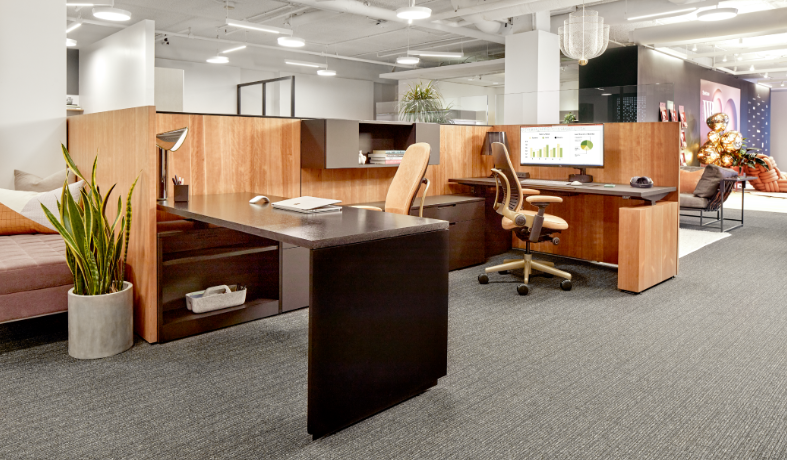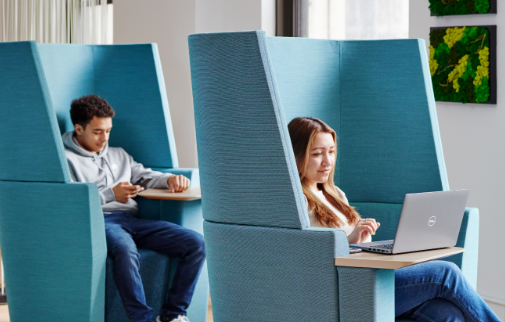Why access to privacy solutions is critical in today’s workplace.
Hybrid work is taxing our brains in new ways. We’re having to think ahead and make all sorts of decisions we didn’t have to prior to the proliferation of hybrid work. Should I book a space for a meeting? Do I have work that requires individual focus time? If I’m in meetings are the participants in-office, remote or both? What if I don’t have an assigned space, is it okay to take a video call in the open? If I have workspace, will I distract others if I do virtual meetings there?
All of these questions connect closely to what people want most in the workplace now, according to new Steelcase research. Employees in 11 countries ranked privacy #1 on their list. Spaces for wellbeing are a close second. No surprise, say researchers. The ability to access privacy and find places in the office that help us think and feel better are woven tightly together.
New Motivations
To better understand the new demands and motivations surrounding hybrid work, Steelcase researchers in Europe and Asia conducted interviews, diary studies and surveys with hundreds of employees and what they found is relevant around the world.
“What’s new is just how many meetings are taking place that add to the distractions in the workplace. People tell us they don’t have enough options for privacy, especially as more workplaces shift away from owned workspaces and toward more shared individual spaces,” says Andrada losif, Steelcase WorkSpace Futures researcher.

Three privacy factors
Whether consciously or subconsciously, three factors influence when people seek out more privacy.
What’s around me?
People evaluate the types of space available. How much privacy their personal work space provides. How many people are nearby and what company culture suggests about taking meetings in an open space.
What am I doing?
Employees consider how much they need to focus on any given task. How confidential is the work? Can I be interrupted? How long is the meeting? What technology do I need? Is the conversation personal?
How do I feel?
Preferences, self-awareness and mood also influence people. Some days people need a breather or to get “off stage” when situated in a space where others can see and hear. Other people get energized being near colleagues.
Designers say people need a range of privacy solutions everyone can access to give people more control over the stimulation around them based on the cognitive demands of what they’re doing. Options should include spaces with acoustic, visual and territorial privacy.
Privacy is both personal and contributes to productivity. It enables focus, connection with others and rejuvenation. By giving everyone – no matter their role – access to different kinds of private spaces. The workplace can do a better job of supporting how people feel and the work they need to do throughout each day.
Privacy gives people time to self-reflect and process information and ideas, or thoughts and feelings. Giving people control over their privacy, gives them access to ways to create boundaries and a sense of self-control which can help people manage their mental wellbeing, especially on high-stress days.”
Andrada losif: Steelcase Workspace Futures Researcher
A Range of Privacy Solutions


Less Control and Demand
People are more likely to choose an individual space in the open when their work requires less focus or lower cognitive command, like a call they are listening to, sending a few emails, or when you are on the receiving end of an information share-out. Boundaries like screens, and framing or shielding elements help denote someone’s territory and limit distractions, such as people walking in the background or other interruptions.

Moderate Control and Demand
There’s a middle ground, too. People may be willing to be seen, but not heard, or vice versa. Or they may want to stay accessible to their teams, but signal that they are working on something that requires heads down time. Semi-enclosed spaces are a good option for this kind of work, giving people a place that limits distractions yet lets them be near teammates.

High Control and Demand
People seek greater levels of privacy when they have highly confidential work, need to focus deeply or need some respite – things that require more mental acuity or feel control over everyday workplace distractions. In these kinds of moments, employees are most likely to reserve a space that gives them more acoustic and visual privacy.
Read more about creating privacy in small offices here.
Receive our Newsletter
To receive our newsletter, including new editions of spaces and other digital content, fill out the form:



